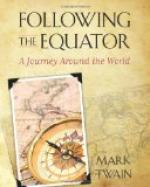The shield was the customary war-shield of his race, and would not be a protection to you or to me. It is no broader than a stovepipe, and is about as long as a man’s arm. The opposing surface is not flat, but slopes away from the centerline like a boat’s bow. The difficulty about a cricket-ball that has been thrown with a scientific “twist” is, that it suddenly changes it course when it is close to its target and comes straight for the mark when apparently it was going overhead or to one side. I should not be able to protect myself from such balls for half-an-hour, or less.
Mr. Chauncy once saw “a little native man” throw a cricket-ball 119 yards. This is said to beat the English professional record by thirteen yards.
We have all seen the circus-man bound into the air from a spring-board and make a somersault over eight horses standing side by side. Mr. Chauncy saw an aboriginal do it over eleven; and was assured that he had sometimes done it over fourteen. But what is that to this:
“I saw the same man leap from the ground, and in going over he dipped his head, unaided by his hands, into a hat placed in an inverted position on the top of the head of another man sitting upright on horseback—both man and horse being of the average size. The native landed on the other side of the horse with the hat fairly on his head. The prodigious height of the leap, and the precision with which it was taken so as to enable him to dip his head into the hat, exceeded any feat of the kind I have ever beheld.”
I should think so! On board a ship lately I saw a young Oxford athlete run four steps and spring into the air and squirm his hips by a side-twist over a bar that was five and one-half feet high; but he could not have stood still and cleared a bar that was four feet high. I know this, because I tried it myself.
One can see now where the kangaroo learned its art.
Sir George Grey and Mr. Eyre testify that the natives dug wells fourteen or fifteen feet deep and two feet in diameter at the bore—dug them in the sand—wells that were “quite circular, carried straight down, and the work beautifully executed.”
Their tools were their hands and feet. How did they throw sand out from such a depth? How could they stoop down and get it, with only two feet of space to stoop in? How did they keep that sand-pipe from caving in on them? I do not know. Still, they did manage those seeming impossibilities. Swallowed the sand, may be.
Mr. Chauncy speaks highly of the patience and skill and alert intelligence of the native huntsman when he is stalking the emu, the kangaroo, and other game:




